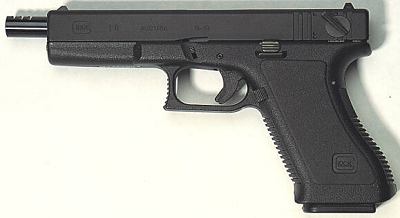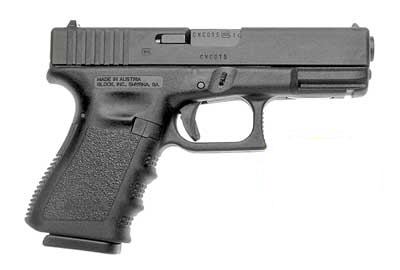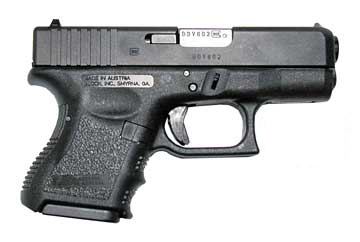Glock parts diagram.
Glock 18 - select-fire model (9mm). Early version with extended barrel and integral compensator.
Note fire mode selector switch on the slide.
Note fire mode selector switch on the slide.
Glock 19 - semi-compact model (9mm).
Glock 26 - compact model (9mm).
The Glock family of pistols, once started by famous Glock 17 pistol, was developed by Austrian company Glock Gmbh., previously known for quality knives and entrenching tools. The Glock 17 pistol first appeared at the Austrian Army trials, won it and was adopted by Austrai Army and Police in the early 1980s under the designation of P-80. Since then, the Glock 17 and its descentants become very popular military and law enforcement firearms, being exported in more than 50 countries. Currently, Glocks are chambered in all major pistol calibers, namely 9x17mm Short (.380ACP), 9x19mm Luger, .357SIG, .40SW, 10mm auto and .45ACP. Also, Glocks available in full-size service models, semi-compact models, compact models for concealed/backup carry, and in longslide competition models. Training versions, firing non-lethal practice ammo, also available. Training versions are distinguished from "live" ones by frame colour - blue frame for guns that fire non-lethal ammunition and red frame - for non-firing guns.
All Glocks (except for ones chambered in 9x17 - .380ACP) are recoil operated, locked breech pistols. Glocks feature Browning-type linkless locking system with barrel interlocking with slide via ejection port. All Glocks feature patented "Safe action" striker-fired trigger mechanism. After the each cycle of the slide the striker is set to half-cock position and is safely blocked by internal safety. When shooter pulls the trigger, he disengades the trigger safety first, then cocks the striker to the full-cock and then fires the gun. This results in constant trigger pull (ajustable from 2 to 5.5 kg) and, unlike the traditional DA or DAO pistols, unavailability of the "second strike" option in case of the misfire. All Glocks has no external controls except the trigger and the slide stop (the only different is Glock 18, which has slide mounted fire mode selector).
The .380ACP / 9x17mm Short chambered Glocks (models 25 and 28) differs from the rest of the Glock family by operating by simple blowback principle. These pistols targeted for civilian markets where ownership of the firearms chambered in "military" calibers is prohibited, or for those shooters who can't withstand more severe recoil of the "bigger" calibers.
All Glocks feature polymer frame, steel slides made by precision moulding process and had Tenifer heat-threatment to increase rust and wear risistance. early Glocks had plain grips with slight serrations. Modern variants has finger grooves on the front strap of the grip, and ambidextrous thumb rests. Also, modern versions featured underbarrel acessory rails. Barrels has hexagonal rifling in all calibers. Both front and rear sights are dovetailed and usually had white or luminous inserts. Ajustable sights are available for competition models.
Almost all models had modifications with factory-ported barrels. These models are marked with suffix "C" after the model number, i.e. Glock 17C.
The Glock 17 (and only model 17) could be modified with "amphibious kit" that allows underwater firing (in wery shallow depths, thought). Basically, the underwater shooting itself has wery little effect in real combat, since the effective range is extermely short. The real purpose of that feature is to show the strenght of the gun and to allow safe shoting in severe weather conditions, with possible water in the barrel (in many guns this may result in blown barrel).
The select-fire version of the Glock, called Glock 18, available only in 9mm Luger and only for Military / Law enforcement sales. Glock 18 could fire single shots or three-shot bursts. Glock 18 may be equipped with 31-rounds extended magazines and after-market folding stocks. For security reasons, some parts of the Glock 18 ARE NOT interchangeable with Glock 17/19 pistols. The theoretical rate of fire in full-auto mode is 1200 rounds per minute.
All Glocks (except for ones chambered in 9x17 - .380ACP) are recoil operated, locked breech pistols. Glocks feature Browning-type linkless locking system with barrel interlocking with slide via ejection port. All Glocks feature patented "Safe action" striker-fired trigger mechanism. After the each cycle of the slide the striker is set to half-cock position and is safely blocked by internal safety. When shooter pulls the trigger, he disengades the trigger safety first, then cocks the striker to the full-cock and then fires the gun. This results in constant trigger pull (ajustable from 2 to 5.5 kg) and, unlike the traditional DA or DAO pistols, unavailability of the "second strike" option in case of the misfire. All Glocks has no external controls except the trigger and the slide stop (the only different is Glock 18, which has slide mounted fire mode selector).
The .380ACP / 9x17mm Short chambered Glocks (models 25 and 28) differs from the rest of the Glock family by operating by simple blowback principle. These pistols targeted for civilian markets where ownership of the firearms chambered in "military" calibers is prohibited, or for those shooters who can't withstand more severe recoil of the "bigger" calibers.
All Glocks feature polymer frame, steel slides made by precision moulding process and had Tenifer heat-threatment to increase rust and wear risistance. early Glocks had plain grips with slight serrations. Modern variants has finger grooves on the front strap of the grip, and ambidextrous thumb rests. Also, modern versions featured underbarrel acessory rails. Barrels has hexagonal rifling in all calibers. Both front and rear sights are dovetailed and usually had white or luminous inserts. Ajustable sights are available for competition models.
Almost all models had modifications with factory-ported barrels. These models are marked with suffix "C" after the model number, i.e. Glock 17C.
The Glock 17 (and only model 17) could be modified with "amphibious kit" that allows underwater firing (in wery shallow depths, thought). Basically, the underwater shooting itself has wery little effect in real combat, since the effective range is extermely short. The real purpose of that feature is to show the strenght of the gun and to allow safe shoting in severe weather conditions, with possible water in the barrel (in many guns this may result in blown barrel).
The select-fire version of the Glock, called Glock 18, available only in 9mm Luger and only for Military / Law enforcement sales. Glock 18 could fire single shots or three-shot bursts. Glock 18 may be equipped with 31-rounds extended magazines and after-market folding stocks. For security reasons, some parts of the Glock 18 ARE NOT interchangeable with Glock 17/19 pistols. The theoretical rate of fire in full-auto mode is 1200 rounds per minute.
9x19mm Glock family basic data (.40SW and .357SIG models has the same dimensions, but weight slightly more)
| GLOCK 17 | GLOCK 18 (select-fire) | GLOCK 19 | GLOCK 26 | |
| Lenght, mm | 186 | 186 | 174 | 160 |
| Barrel lenght, mm | 114 | 114 | 102 | 88 |
| Weight empty, g | 625 | 625 | 595 | 560 |
| Capacity, rds | 10, 17, 19, 31 | 10, 17, 19, 31 | 10, 15, 17 | 10, 12 |


 00.24
00.24
 Jack The Ripper
Jack The Ripper






 Posted in:
Posted in:
0 komentar:
Posting Komentar